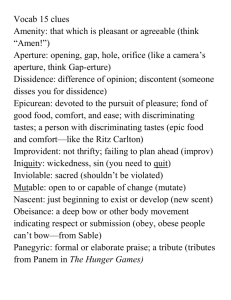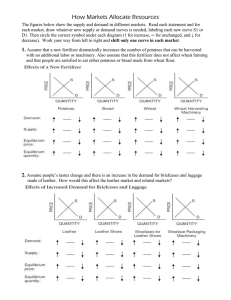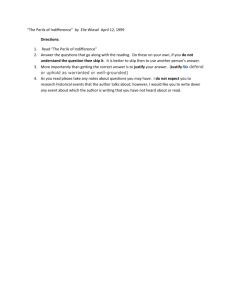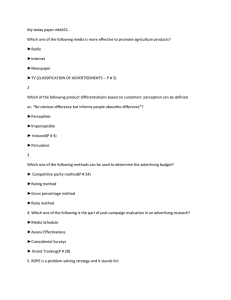4 Tastes and Indifference Curves C H A P T E R
advertisement
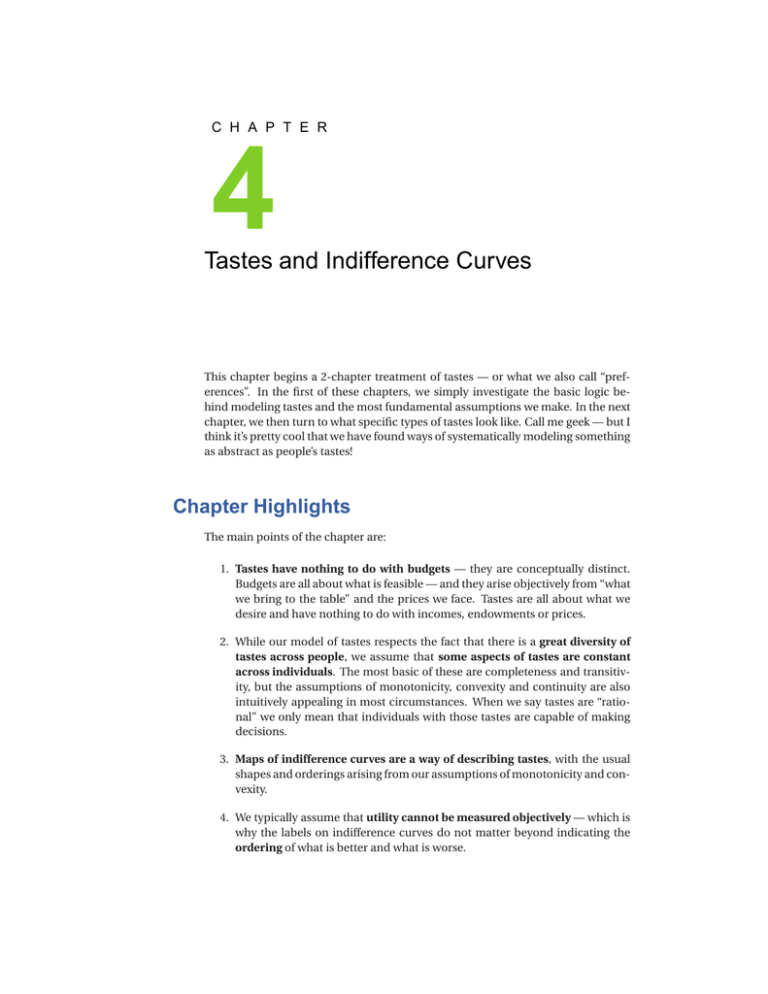
C H A P T E R 4 Tastes and Indifference Curves This chapter begins a 2-chapter treatment of tastes — or what we also call “preferences”. In the first of these chapters, we simply investigate the basic logic behind modeling tastes and the most fundamental assumptions we make. In the next chapter, we then turn to what specific types of tastes look like. Call me geek — but I think it’s pretty cool that we have found ways of systematically modeling something as abstract as people’s tastes! Chapter Highlights The main points of the chapter are: 1. Tastes have nothing to do with budgets — they are conceptually distinct. Budgets are all about what is feasible — and they arise objectively from “what we bring to the table” and the prices we face. Tastes are all about what we desire and have nothing to do with incomes, endowments or prices. 2. While our model of tastes respects the fact that there is a great diversity of tastes across people, we assume that some aspects of tastes are constant across individuals. The most basic of these are completeness and transitivity, but the assumptions of monotonicity, convexity and continuity are also intuitively appealing in most circumstances. When we say tastes are “rational” we only mean that individuals with those tastes are capable of making decisions. 3. Maps of indifference curves are a way of describing tastes, with the usual shapes and orderings arising from our assumptions of monotonicity and convexity. 4. We typically assume that utility cannot be measured objectively — which is why the labels on indifference curves do not matter beyond indicating the ordering of what is better and what is worse. 29 4A. Solutions to Within-Chapter-Exercises 5. The slope of an indifference curve — or the marginal rate of substitution — at a particular bundle tells us how an individual feels about different goods at the margin — i.e. how much the individual is willing to trade one good for another given that she currently has this particular bundle. Using the LiveGraphs For an overview of what is contained on the LiveGraphs site for each of the chapters (from Chapter 2 through 29) and how you might utilize this resource, see pages 2-3 of Chapter 1 of this Study Guide. To access the LiveGraphs for Chapter 4, click the Chapter 4 tab on the left side of the LiveGraphs web site. If you are not covering the mathematical B-part of the text Microeconomics: An Intuitive Approach with Calculus (or if you are using the non-mathematical text entitled Microeconomics: An Intuitive Approach), you will miss some very helpful LiveGraphs unless you look for them. You can either find these under Animated Graphics if you are on the LiveGraphs site for the larger book with calculus — or you can find them under the Exploring Relationships tab if you are on the LiveGraphs site for the shorter intuitive text without calculus. The four animations include: 1. First, the animation for Indifference Curves & Utility Functions: 3D Object in 2D Space (which is Graph 4.8 in the calculus-based text) illustrates how indifference curves relate to utility “mountains” (or utility functions). 2. Second, the two animations referring to “Mount Nechyba” (which appear as Graphs 4.9 and 4.10 in the calculus-based text) illustrate how we graph 3D mountains in two dimensions — exactly as we do indifference curves. 3. Third, a final graph re-scales the utility function (or “mountain”) and illustrates how only the labels but not the shapes of indifference curves change as a result. (This is Graph 4.11 in the calculus-based text.) 4A Solutions to Within-Chapter-Exercises Exercise 4A.1 Do we know from the monotonicity assumption how E relates to D, A and B? Do we know how A relates to D? Answer: E must be preferred to D because it contains more of everything (i.e. more pants and more shirts). Monotonicity does not tell us anything about the relationship between A and E — A has more shirts but fewer pants and E has more pants but fewer shirts. For analogous reasons, monotonicity does not tell us anything about how E and B are ranked. A has more shirts and the same number of pants as D — so we know that A is at least as good as D (and probably better). Tastes and Indifference Curves 30 Exercise 4A.2 What other goods are such that we would prefer to have fewer of them rather than many? How can we re-conceptualize choices over such goods so that it becomes reasonable to assume “more is better”? Answer: Examples might include pollution, bugs in our houses, weeds in our yard and disease in our bodies. In each case, however, we can re-conceptualize the “bad” by redefining it into a “good” that we want more of. We want less pollution but more clean air and water; fewer bugs in our houses or more “bug-free” square feet of housing; fewer weeds in our yard but more square feet of weed-less grass; less disease and more health. Exercise 4A.3 Combining the convexity and monotonicity assumptions, can you now conclude something about the relationship between the pairs E and A and E and B if you do not know how A and B are related? What if you know that I am indifferent between A and B? Answer: We can only apply the convexity assumption if we know some pair of bundles we are indifferent between — because convexity says that, when faced with bundles we are indifferent between, we prefer averages of such bundles (or at the very least like averages just as much). So, without knowing more, I can’t use monotonicity and convexity to say anything about how A and E (or B and E ) are related to one another. If we know that I am indifferent between A and B, on the other hand, then I know that C is at least as good as A and B because C is the average between A and B. Since E has more of everything than C , we also know from monotonicity that E is better than C . So E is better than C which is at least as good as A and B. By transitivity, that implies that E is better than A and B. Exercise 4A.4 Knowing that I am indifferent between A and B, can you now conclude something about how B and D are ranked by me? In order to reach this conclusion, do you have to invoke the convexity assumption? Answer: By just invoking the monotonicity assumption, I know that A is at least as good as D since it has more of one good and the same of the other. If A is indifferent to B, I then also know (by transitivity) that B is at least as good as D. Invoking convexity won’t actually allow me to say anything beyond that since indifference between A, B and D is consistent with convexity. (It is not consistent with a strict notion of convexity — where by “strict” we mean that averages are strictly better than (indifferent) extremes. In that case, A and B are definitely preferred to D if we are indifferent between A and B.) Exercise 4A.5 Illustrate the area in Graph 4.2b in which F must lie — keeping in mind the monotonicity assumption. Answer: By monotonicity, F must have less than C and must therefore lie to the southwest of C . Thus, it must have no more than 5 shirts and no more than 6 pants. But it also cannot have fewer than 4 pants because then it would contain fewer pants and shirts than A and would therefore be worse than A. And it cannot 31 4A. Solutions to Within-Chapter-Exercises have fewer than 2 shirts because it would then have less of everything than B and could no longer be indifferent to B. F must therefore lie in the area illustrated in Graph 4.1. Graph 4.1: Graph for Within-Chapter-Exercise 4A.5 Exercise 4A.6 Suppose our tastes satisfy weak convexity in the sense that averages are just as good (rather than strictly better than) extremes. Where does F lie in relation to C in that case? Answer: In that case F is the same bundle as C — because C is the average of the more extreme bundles A and B. Exercise 4A.7 Suppose extremes are better than averages. What would an indifference curve look like? Would it still imply diminishing marginal rates of substitution? Answer: The indifference curve would bend away from instead of toward the origin, as illustrated in Graph 4.2 (on the next page). The shaded area to the northeast of the indifference curve would contain all the better bundles (because of monotonicity). But the line connecting A and B — which contains averages between A and B — does not lie in this “better” region. Therefore, averages are worse than extremes. The slope of this indifference curve is then shallow at A and becomes steeper as we move along the indifference curve to B. Thus, the marginal rate of substitution is no longer diminishing along the indifference curve — and the indifference curve exhibits increasing marginal rates of substitution. Exercise 4A.8 Suppose averages are just as good as extremes? Would it still imply diminishing marginal rates of substitution? Answer: If averages are just as good as extremes, then indifference curves are straight lines. As a result, the slope would be the same along an indifference curve — implying constant rather than diminishing marginal rates of substitution. This is Tastes and Indifference Curves 32 Graph 4.2: Non-concex tastes the borderline case between strictly convex tastes that have diminishing marginal rates of substitution and strictly non-convex tastes that have strictly increasing marginal rates of substitution. Exercise 4A.9 Show how you can prove the last sentence in the previous paragraph by appealing to the transitivity of tastes. Answer: Pick any bundle that lies on the bold portion of the indifference curve to the southwest of E and call it B. As noted in the text, we know from monotonicity that E is better than B. Because A and B lie on the same indifference curve, you are indifferent between them. Thus, E is better than B which is indifferent to A. Transitivity then implies that E is better than A. Exercise 4A.10 Suppose less is better than more and averages are better than extremes. Draw three indifference curves (with numerical labels) that would be consistent with this. Answer: Graph 4.3 (on the next page) illustrates three such curves. Since less is better, the consumer becomes better off in the direction of the arrows at the top right of the graph. Thus, if I take A and B that lie on the same indifference curve, the line connecting them (which contains averages of the two) lies fully in the region that is more preferred. Thus, averages are indeed better than extremes. Since the consumer becomes better off as she moves southwest, the numbers accompanying the indifference curves must be increasing as we approach the origin. (Solutions to End-of-Chapter Exercises begin on next page.) 33 4A. Solutions to Within-Chapter-Exercises Graph 4.3: Convex tastes over “bads” End of Chapter Exercises Exercise 4.2 10 Consider my wife’s tastes for grits and cereal. Unlike me, my wife likes both grits and cereal, but for her, averages (between equally preferred bundles) are worse than extremes. (a) On a graph with boxes of grits on the horizontal and boxes of cereal on the vertical, illustrate three indifference curves that would be consistent with my description of my wife’s tastes. Answer: This is illustrated in Graph 4.4. The shapes of these indifference curves arise from the following observation: Consider A and B that lie on the same indifference curve. Bundle C is the average of A and B — and since averages are worse than extremes, C must lie below the indifference curve that contains A and B . Graph 4.4: Grits and Cereal Tastes Tastes and Indifference Curves 34 (b) Suppose we ignored labels on indifference curves and simply looked at shapes of the curves that make up our indifference map. Could my indifference map look the same as my wife’s if I hate both cereal and grits? If so, would my tastes be convex? Answer: Yes, I would simply become better off as I move in the direction of the origin in the graph while my wife would become better off moving in the opposite direction. And my tastes would indeed be convex in this case — because C would now lie “above” the indifference curve that contains A and B in the sense that I become better off as I move to the southwest in the graph. Exercise 4.5 11 In this exercise, we explore the concept of marginal rates of substitution further. Suppose I own 3 bananas and 6 apples, and you own 5 bananas and 10 apples. (a) With bananas on the horizontal axis and apples on the vertical, the slope of my indifference curve at my current bundle is −2, and the slope of your indifference curve through your current bundle is −1. Assume that our tastes satisfy our usual five assumptions. Can you suggest a trade to me that would make both of us better off? (Feel free to assume we can trade fractions of apples and bananas). Answer: The slope of my indifference curve at my bundle tells us that I am willing to trade as many as 2 apples to get one more banana. The slope of your indifference curve at your bundle tells us that you are willing to trade apples and bananas one for one. If you offer me 1 banana in exchange for 1.5 apples, you would be better off because you would have been willing to accept as little as 1 apple for 1 banana. I would also be better off because I would be willing to give you as many as 2 apples for 1 banana — only having to give you 1.5 apples is better than that. (If you are uncomfortable with fractions of apples being traded, you could also propose giving me 2 bananas for 3 apples.) This is only one possible example of a trade that would make us both better off. You could propose to give me 1 banana for x apples, where x can lie between 1 and 2. Since I am willing to give up as many as 2 apples for one banana, any such trade would make me better off, and since you are willing to trade them one for one, the same would be true for you. (b) After we engage in the trade you suggested, will our MRS’s have gone up or down (in absolute value)? Answer: Any trade that makes both of us better off moves me in the direction of more bananas and fewer apples — which, given diminishing marginal rates of substitution, should decrease the absolute value of my MRS; i.e. as I get more bananas and fewer apples, I will be willing to trade fewer apples to get one more banana than I was willing to originally. You, on the other hand, are giving up bananas and getting apples, which moves you in the opposite direction toward fewer bananas and more apples. Thus, you will become less willing to grade 1 banana for 1 apple and will in future trades demand more bananas in exchange for 1 apple. Thus, in absolute value, your MRS will get larger. (c) If the values for our MRS’s at our current consumption bundles were reversed, how would your answers to (a) and (b) change? Answer: The trades would simply go in the other direction; i.e. I would be willing to trade 1 banana for x apples so long as x is at least 1, and you would be willing to accept such a trade so long as x is no more than 2. Thus, x again lies between 1 and 2 if both of us are to be better off from the trade, only now I am giving you bananas in exchange for apples rather than the other way around. (d) What would have to be true about our MRS’s at our current bundles in order for you not to be able to come up with a mutually beneficial trade? Answer: In order for us not to be able to trade in a mutually beneficial way, your MRS at your current bundle would have to be identical to my MRS at my current bundle. (e) True or False: If we have different tastes, then we will always be able to trade with both of us benefitting. 35 4A. Solutions to Within-Chapter-Exercises Answer: This statement is generally false. What matters is not that we have different tastes (i.e. different maps of indifference curves). What matters instead is that, at our current consumption bundle, we value goods differently — that at our current bundle, our MRS’s are different. It is quite possible for us to have different tastes (i.e. different maps of indifference curves) but to also be at bundles where our MRS is the same. In that case, we would have the same tastes at the margin even though we have different tastes overall (i.e. different indifference maps.) (f) True or False: If we have the same tastes, then we will never be able to trade with both of us benefitting. Answer: False. People with the same tastes but different bundles of goods may well have different marginal rates of substitution at their current bundles — and this opens the possibility of trading with benefits for both sides. Exercise 4.10: Investor Tastes over Risk and Return 12 Business Application: Investor Tastes over Risk and Return: Suppose you are considering where to invest money for the future. Like most investors, you care about the expected return on your investment as well as the risk associated with the investment. But different investors are willing to make different kinds of tradeoffs relative to risk and return. (a) On a graph, put risk on the horizontal axis and expected return on the vertical. (For purposes of this exercise, don’t worry about the precise units in which these are expressed.) Where in your graph would you locate “safe” investments like inflation indexed government bonds — investments for which you can predict the rate of return with certainty? Answer: Such investments would appear on the vertical axis since risk is represented on the horizontal axis. All such investments have zero risk. (b) Pick one of these “safe” investment bundles of risk and return and label it A. Then pick a riskier investment bundle B that an investor could plausibly find equally attractive (given that risk is bad in the eyes of investors while expected returns are good). Answer: Panel (a) of Graph 4.5 depicts a safe investment A on the vertical axis. An investment bundle with risk must then have a higher return since investors like greater returns and less risk. Put differently, investors become better off moving up and to the left (as indicated by the arrows in the top left of panel (a)), which means that bundles indifferent to A must lie to the northeast. Graph 4.5: Tastes over Risk and Return Tastes and Indifference Curves 36 (c) If your tastes are convex and you only have investments A and B to choose from, would you prefer diversifying your investment portfolio by putting half of your investment in A and half in B ? Answer: Such diversification would result in bundle C in panel (a) of the graph. Convexity of tastes implies the illustrated shape of the indifference curve through A and B — such that the set of bundles better than A (and B ) is a convex set. This causes C to lie to the northwest of some of the bundles that are indifferent to A and B , which means C must be preferred to A and B . So, yes, you would choose to diversify. (d) If your tastes are non-convex, would you find such diversification attractive? Answer: If tastes are not convex, then C lies below the indifference curve through A and B as illustrated in panel (b) of the graph. Thus, you would not choose to diversify. Exercise 4.13 13 In this exercise, we will explore some logical relationships between families of tastes that satisfy different assumptions. Suppose we define a strong and a weak version of convexity as follows: Tastes are said to be strongly convex if, whenever a person with those tastes is indifferent between A and B , she strictly prefers the average of A and B (to A and B ). Tastes are said to be weakly convex if, whenever a person with those tastes is indifferent between A and B , the average of A and B is at least as good as A and B for that person. (a) Let the set of all tastes that satisfy strong convexity be denoted as SC and the set of all tastes that satisfy weak convexity as W C . Which set is contained in the other? (We would, for instance, say that “W C is contained in SC ” if any taste that satisfies weak convexity also automatically satisfies strong convexity.) Answer: Suppose your tastes satisfy the strong convexity condition. Then you always strictly prefer averages to extremes (where the extremes are such that you are indifferent between them). That automatically means that the average between such extremes is at least as good as the extremes — which means that your tastes automatically satisfy weak convexity. Thus, the set SC must be fully contained within the set W C . (b) Consider the set of tastes that are contained in one and only one of the two sets defined above. What must be true about some indifference curves on any indifference map from this newly defined set of tastes? Answer: We already concluded above that all strongly convex tastes are also weakly convex. So tastes that are strongly convex cannot be in the newly defined set because they appear in both SC and W C — and we are defining our new set to contain tastes that are only in one of these sets. The newly defined set therefore contains only tastes that satisfy weak convexity but not strong convexity. The only difference between weak and strong convexity is that the former permits averages to be just as good as extremes while the latter insists that averages are strictly better than extremes. When an average is just as good as two extremes from the same indifference curve, it must be that the line connecting the extremes is all part of the same indifference curve. Thus, some indifference curves in a weakly convex indifference map that lies outside SC must have “flat spots” that are line segments. (c) Suppose you are told the following about 3 people: Person 1 strictly prefers bundle A to bundle B whenever A contains more of each and every good than bundle B . If only some goods are represented in greater quantity in A than in B while the remaining goods are represented in equal quantity, then A is at least as good as B for this person. Such tastes are often said to be weakly monotonic. Person 2 likes bundle A strictly better than B whenever at least some goods are represented in greater quantity in A than in B while others may be represented in equal quantity. Such tastes are said to be strongly monotonic. Finally, person 3’s tastes are such that, for every bundle A, there always exists a bundle B very close to A that is strictly better than A. Such tastes are said to satisfy local nonsatiation. Call the set of tastes that satisfy strict monotonicity SM, the set of tastes that satisfy weak monotonicity W M, and the set of tastes that satisfy local non-satiation L. What is the relationship between these sets? Put differently, is any set contained in any other set? 37 4A. Solutions to Within-Chapter-Exercises Answer: If your tastes satisfy strong monotonicity, it means that A is strictly preferred to B even if A and B are identical in every way except that A has more of one good than B . This means that your tastes would automatically satisfy weak monotonicity — because weak monotonicity only requires that A is at least as good under that condition and thus permits indifference between A and B unless all goods are more highly represented in A than in B . All strongly monotone tastes are weakly monotone, which means SM is fully contained in W M. Local non-satiation only requires that, for every bundle A, there exists some bundle B close to A such that B is preferred to A. If your tastes satisfy strong monotonicity, then we know such a bundle always exists: Begin at some A and then add a tiny bit of every good to A to form B . As long as we add a tiny bit to all goods, strong monotonicity says B is strictly better than A. The same works for weakly monotonic tastes. Thus, both SM and W M are fully contained in L. But there are also tastes in L such that these tastes are not in W M. Consider tastes where at some bundle A there are no bundles with more goods close to A that are preferred to A but there is a bundle with slightly fewer goods that is preferred to B . Then such tastes would satisfy local non-satiation but not weak (or strong) convexity. (d) Give an example of tastes that fall in one and only one of these three sets? Answer: Since we have just concluded that SM is contained in W M which is contained in L, such tastes must satisfy local non-satiation but not weak monotonicity. Consider tastes over labor and consumption. We would generally like to expend less labor and have more consumption. Such tastes are not strongly or weakly monotonic because A is strictly less preferred to B if A contains the same amount of consumption but more labor. But they do satisfy local non-satiation because for every A, we can make the person better off through less labor or more consumption (or both). (e) What is true of tastes that are in one and only one of the two sets SM and W M? Answer: Since SM is contained in W M, such tastes must be weakly monotonic. (If they were strongly monotonic, they would be contained in both sets). Consider bundles A and B that are identical in every way except that A has more of one of the goods than B . For tastes to be weakly monotonic but not strongly monotonic, it must be that there exists such an A and B and that a person with such tastes is indifferent between A and B . (If such a person strictly preferred all such A bundles to all such B bundles, her tastes would be strongly monotonic.) Thus, tastes that fall in W M but not SM must have some indifference curves with either horizontal or vertical “flat spots”. Conclusion: Potentially Helpful Reminders 1. Convexity in tastes is easy to recognize when “more is better” — but might be a bit confusing otherwise. Here is a simple trick to check whether the tastes you have drawn are convex: Use two arrows that have the same starting point and indicate which horizontal and vertical direction is “better” for the consumer. (When tastes are monotonic, these point to the right and up.) Convexity then implies that the indifference curves bend toward the corner of the arrows you have drawn. (Graph 4.3 in the answer to within-chapter exercise 4A.10 has an example of this. Another example is in Graph 4.6 in the answer to end-of-chapter exercise 4.11.) 2. It should be reasonably clear that tastes — how we subjectively feel about stuff — should not typically depend on prices (which only affect what we can objectively afford). Put differently, our circumstances are different from our tastes. But sometimes that gets a little hazy when circumstances other than the usual budget parameters matter. An example of this is given in end-of- Tastes and Indifference Curves 38 chapter exercise 4.7 where we think of “air safety” as one of the circumstances a consumer cannot himself change. 3. Exercise 4.5 is a good exercise to prepare for some of the ideas that are coming up in Chapter 6 as well as later on in Chapter 16. 4. But the last two end-of-chapter exercises are relatively abstract and probably beyond the level of most (but not all) courses that use this text.


